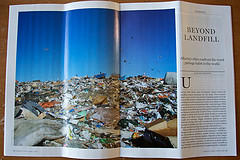Scott posted a Christmas wish – that people would go to the FlatWorldKnowledge library and download one of the books available under the Creative Commons license before that form of access is revoked at the end of the year.
FlatWorldKnowledge started out by being rather awesome – collecting and publishing a series of supposedly high quality1 books with a few options. If you want an eBook copy or PDF or even print, that’s available for a nominal fee. Or, you can have free access through the FlatWorldKnowledge website for free2.
The books are all labeled as being available under the Creative Commons Attribution Non-Commercial Share-Alike license. Awesome! So, students (and others) are able, even encouraged, to download the book for their own use (and re-use).
Except that the books are only available in a format that makes it extremely difficult to actually download more than a single page, or by ponying up $34.95 for a PDF version that includes everything.
Now, I’m all for making money. I wouldn’t mind some, myself. I also get that a company needs to make money, or there’s no point in them doing anything. But, you can’t just slap a license on a page and claim to be open. Open is as much about making it easy as it is about the license. It’s about lowering the costs of use and reuse – and the costs aren’t just about financial transactions.
Under the model adopted by FlatWorldKnowledge, as a student I am able to more easily and quickly photocopy a book for my personal use than I am to save a copy of their open book from the website. That’s messed up. If anything, this serves as a scathing indictment on the viability of an open content business model. Or, for the particular business model originally adopted by FlatWorldKnowledge.
If you’re going to be open, be open. That involves having options for free access, and enabling people to effectively use and reuse the content. If you’re not going to be open, that’s fine. There is no requirement that anyone adopts a particular license or stance on sharing. Own that decision. But don’t straddle the fence trying to reap the PR buzz from being open, while blocking real access to the content and propping up paywalls and technical barriers.
- I can’t speak to the actual quality – the books look decent enough on first glance [↩]
- you get free access to their “study tools” for 14 days, but I think you get ongoing free access to the book on their website, and can continue to have access to the “study tools” for an additional $19.95 subscription [↩]




